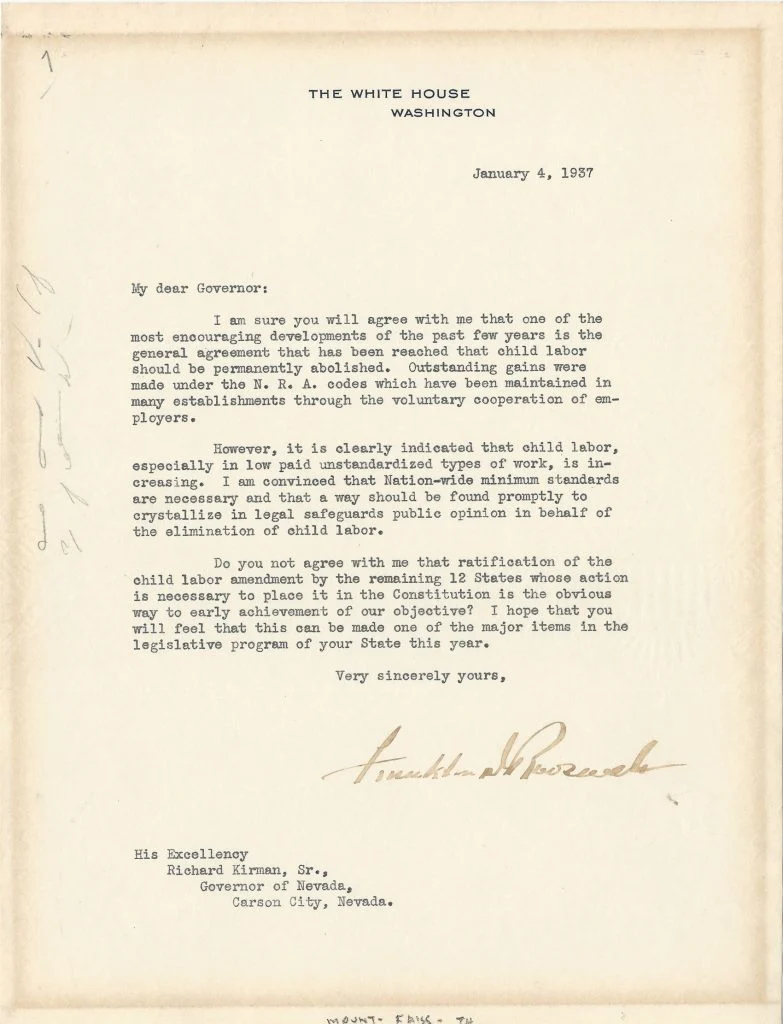President Franklin D. Roosevelt Is Proud of the Progress Made Against Child Labor by the New Deal’s National Recovery Administration

He praises the “outstanding gains”, and seeks passage of a constitutional amendment to end child labor once and for all.
As the United States industrialized, factory and mine owners hired children for a variety of tasks, as they were especially useful in fixing machinery and navigating the small areas that fully grown adults could not. Children were often hired together with their parents, and many families in mill and mining towns depended...
As the United States industrialized, factory and mine owners hired children for a variety of tasks, as they were especially useful in fixing machinery and navigating the small areas that fully grown adults could not. Children were often hired together with their parents, and many families in mill and mining towns depended on their children’s labor to make enough money for necessities. But conditions were deplorable, and it was dangerous work that resulted in the maiming and death of many children. If this was not bad enough, the working children were deprived of the opportunity of going to school. At the start of the 20th century organizations were formed that sought laws to regulate, and even to prohibit, child labor.
Many states passed measures regulating child labor, but these varied in the protections provided and were mainly inadequate. Congress made two attempts to pass legislation against child labor during the Wilson administration, but the U.S. Supreme Court struck them down as unconstitutional. So in 1924 efforts were made to pass a constitutional amendment prohibiting child labor; but the effort failed. The Great Depression caused a change in public opinion, however, as adults had become so desperate for jobs that they would work for the same wage as children.
When FDR took office as president, only four states had laws prohibiting children from working in outside employment under the age of 16. One of his greatest New Deal measures, the National Recovery Administration (NRA), spoke directly to that problem, establishing child labor regulations with that exact prohibition. This effectively ended child labor in American industries and trades, a huge accomplishment, and one of which Roosevelt was justly proud.
But Roosevelt was acting on a number of fronts. By 1937, 28 of the 38 states needed to ratify a constitutional amendment against child labor had approved it. The President set out to get the additional states to ratify. This letter is part of that effort. Typed letter signed, on White House letterhead, Washington, January 4, 1937, to Nevada Governor Richman Kirman, whom he addresses as “My dear Governor”. “I am sure you will agree with me that one of the most encouraging developments of the past few years is the general agreement that has been reached that child labor should be permanently abolished. Outstanding gains were made under the N. R. A. codes which have been maintained in many establishments through the voluntary cooperation of employers.
However, it is clearly indicated that child labor, especially in low paid unstandardized types of work, is increasing. I am convinced that Nation-wide minimum standards are necessary and that a way should be found promptly to crystallize in legal safeguards public opinion in behalf of the elimination of child labor.
Do you not agree with me that ratification of the child labor amendment by the remaining 12 States whose action is necessary to place it in the Constitution is the obvious way to early achievement of our objective? I hope that you will feel that this can be made one of the major items in the legislative program of your State this year.”
The third front on which FDR was acting was legislative. He soon proposed a statute that became the Fair Labor Standards Act, which introduced the forty-hour work week, established a federal minimum wage, required overtime pay for overtime work, and prohibited child labor outside of specifically delineated circumstances, such as for family owned businesses. As states like Nevada were considering ratification of a constitutional amendment, Congress proceeded to pass the bill. FDR signed the Fair Labor Standards Act into law on June 25, 1938. This obviated the need for the amendment, and when the Supreme Court unanimously upheld the constitutionality of the act, the effort for a constitutional amendment ended.

Frame, Display, Preserve
Each frame is custom constructed, using only proper museum archival materials. This includes:The finest frames, tailored to match the document you have chosen. These can period style, antiqued, gilded, wood, etc. Fabric mats, including silk and satin, as well as museum mat board with hand painted bevels. Attachment of the document to the matting to ensure its protection. This "hinging" is done according to archival standards. Protective "glass," or Tru Vue Optium Acrylic glazing, which is shatter resistant, 99% UV protective, and anti-reflective. You benefit from our decades of experience in designing and creating beautiful, compelling, and protective framed historical documents.
Learn more about our Framing Services








































































































